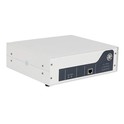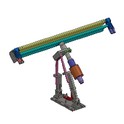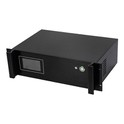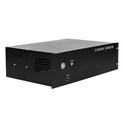Ultrasonic technology has emerged as a powerful tool in various industrial and scientific applications, with ultrasonic sterilization being one of the most promising areas. As a supplier of a 6000W ultrasonic generator, I often receive inquiries about the feasibility of using such high - power equipment for ultrasonic sterilization. In this blog post, I'll delve into the science behind ultrasonic sterilization, evaluate whether a 6000W ultrasonic generator is suitable for this purpose, and discuss the advantages and considerations associated with it.
Understanding Ultrasonic Sterilization
Ultrasonic sterilization operates on the principle of cavitation. When ultrasonic waves propagate through a liquid medium, they create alternating high - and low - pressure cycles. During the low - pressure phase, tiny bubbles or cavities are formed in the liquid. These cavities then collapse violently during the high - pressure phase, a phenomenon known as cavitation. The collapse of these bubbles generates extremely high temperatures (up to several thousand degrees Celsius) and pressures (up to hundreds of atmospheres) for a very short period. These intense conditions can disrupt the cell membranes of microorganisms, break down their internal structures, and ultimately lead to their inactivation or death.
Factors Affecting Ultrasonic Sterilization
Several factors influence the effectiveness of ultrasonic sterilization. The frequency of the ultrasonic waves is a crucial parameter. Different microorganisms may respond differently to various frequencies. Generally, frequencies in the range of 20 - 100 kHz are commonly used for sterilization purposes, as they are more likely to produce the cavitation effect required for microbial inactivation.
The power of the ultrasonic generator also plays a significant role. Higher power can potentially generate more intense cavitation, leading to more effective sterilization. However, it's not as simple as just increasing the power indefinitely. Excessive power may cause damage to the treated materials or lead to the formation of unwanted by - products.
The duration of ultrasonic treatment is another important factor. Longer treatment times generally increase the probability of inactivating a larger number of microorganisms. However, there is a point of diminishing returns, and extended treatment may also have negative impacts on the treated samples.


Can a 6000W Ultrasonic Generator Be Used for Ultrasonic Sterilization?
The short answer is yes, a 6000W ultrasonic generator can be used for ultrasonic sterilization. Its high power has the potential to generate a more intense cavitation effect compared to lower - power generators. This can be particularly beneficial when dealing with large volumes of liquid or when trying to achieve rapid sterilization.
For industrial applications where large - scale sterilization is required, such as in the food and beverage industry or pharmaceutical manufacturing, a 6000W ultrasonic generator can offer significant advantages. It can treat large batches of liquids in a relatively short period, improving production efficiency.
However, there are also some considerations when using a 6000W ultrasonic generator for sterilization. As mentioned earlier, the high power may cause damage to certain materials. For example, if the treated liquid contains heat - sensitive substances or delicate biological samples, the intense heat generated during cavitation may denature or degrade these components.
In addition, the high - power operation of the generator may also generate a significant amount of heat in the system. This requires proper cooling mechanisms to maintain the temperature within an acceptable range. If the temperature rises too high, it can not only affect the performance of the generator but also have a negative impact on the treated samples.
Comparison with Other Power Ultrasonic Generators
Let's compare the 6000W ultrasonic generator with other commonly used power generators, such as the 2000W Ultrasonic Generator and the 4000W Ultrasonic Generator.
The 2000W ultrasonic generator is suitable for small - scale applications or when dealing with samples that are more sensitive to high power. It can still achieve effective sterilization but may require longer treatment times compared to higher - power generators.
The 4000W ultrasonic generator offers a balance between power and applicability. It can handle medium - sized batches of liquids and is often a popular choice for many laboratory and small - to - medium - scale industrial applications.
In contrast, the 6000W Ultrasonic Generator is designed for large - scale and high - throughput sterilization. It can provide a more powerful cavitation effect and reduce the treatment time significantly, but it also requires more careful consideration of the sample characteristics and system requirements.
Advantages of Using a 6000W Ultrasonic Generator for Sterilization
- High - throughput sterilization: As mentioned earlier, the high power of the 6000W generator allows for the rapid treatment of large volumes of liquid. This is especially useful in industries where large - scale production is involved.
- Enhanced cavitation: The intense cavitation generated by the 6000W generator can be more effective in inactivating a wider range of microorganisms, including those that are more resistant to lower - power ultrasonic treatment.
- Flexibility: It can be used in a variety of applications, from industrial to research settings. With proper adjustment of parameters such as frequency and treatment time, it can be tailored to different sterilization requirements.
Considerations and Precautions
- Sample compatibility: Before using the 6000W ultrasonic generator for sterilization, it's essential to test the compatibility of the treated samples. This may involve conducting small - scale experiments to ensure that the high - power operation does not cause any damage to the samples.
- Cooling system: A reliable cooling system is necessary to prevent overheating of the generator and the treated samples. This may include using water - cooling or air - cooling mechanisms, depending on the specific application.
- Operator training: Operators should receive proper training on the use of the 6000W ultrasonic generator. They need to understand the parameters involved, safety precautions, and how to troubleshoot potential issues.
Conclusion
In conclusion, a 6000W ultrasonic generator can be a powerful tool for ultrasonic sterilization, especially in large - scale industrial applications. Its high power offers the potential for rapid and effective sterilization of large volumes of liquid. However, it also comes with some challenges, such as sample compatibility and heat management.
If you are considering using a 6000W ultrasonic generator for your sterilization needs, I encourage you to reach out to us. Our team of experts can provide you with detailed information, technical support, and guidance on how to optimize the use of our 6000W Ultrasonic Generator for your specific application. Whether you are in the food industry, pharmaceutical manufacturing, or any other field that requires sterilization, we are here to help you make the most of this advanced technology. Contact us today to start a discussion about your procurement needs and explore the possibilities of ultrasonic sterilization with our high - power ultrasonic generators.
References
- Mason, T. J., & Peters, P. J. (2004). Applications of ultrasound in food technology. Ultrasound in Sonochemistry, 11(4), 223 - 231.
- Povey, M. J. W., & Mason, T. J. (1998). Ultrasonics in food processing. CRC Press.
- Suslick, K. S. (1990). Sonochemistry. Science, 247(4940), 1439 - 1445.






